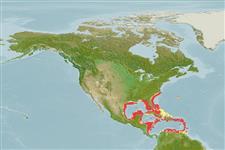Common names from other countries
Classification / Names / Names
Namen | Synonyme | Catalog of Fishes (gen., sp.) | ITIS | CoL | WoRMS
Environment: milieu / climate zone / depth range / distribution range
Ökologie
; tiefenbereich 3 - 183 m (Ref. 83435). Tropical; 35°N - 10°N, 90°E - 65°E (Ref. 83435)
Western Atlantic.
Length at first maturity / Size / Gewicht / Alter
Maturity: Lm ? range ? - ? cm Max length : 35.0 cm DL Männchen/unbestimmt; (Ref. 83435); common length : 35.0 cm TL Männchen/unbestimmt; (Ref. 355)
Shell very large, heavy. Spire short. Shell surface with 3 rows of large knobs on body whorl. Parietal shield large and well defined, triangular. Outer lip with inner tooth-like projections. Colour: pale cream, parietal shield pale to deep salmon. Outer lip entirely cream or cream white sometimes with light brown between teeth.
Largest species of the family in the Atlantic ocean (Ref. 355). Maximum depth from Ref. 109264. On sand bottoms near seagrass beds, at shallow subtidal depths (Ref. 355).
Life cycle and mating behavior
Geschlechtsreife | Fortpflanzung | Ablaichen | Eier | Fecundity | Larven
Members of the order Neotaenioglossa are mostly gonochoric and broadcast spawners. Life cycle: Embryos develop into planktonic trocophore larvae and later into juvenile veligers before becoming fully grown adults.
Leal, J.H. 2003. (Ref. 355)
IUCN Rote Liste Status (Ref. 130435)
CITES Status (Ref. 108899)
Not Evaluated
Not Evaluated
Nutzung durch Menschen
Fischereien: kommerziell
| FishSource |
Tools
Mehr Information
Alter/GrößeWachstumLänge-GewichtLänge-LängeMorphologieLarvenDichte
Internet Quellen
Estimates based on models
Preferred temperature
(Ref.
115969): 21.1 - 27.5, mean 24.8 (based on 130 cells).
Preiskategorie
Unknown.
